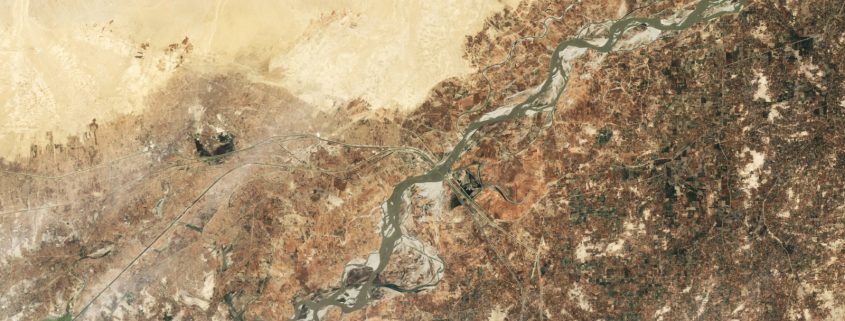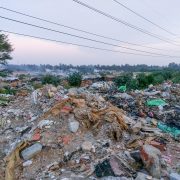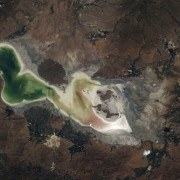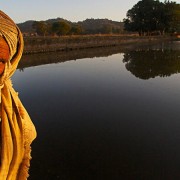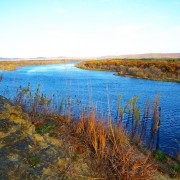India and Pakistan Water Tensions Escalate to The Hague
Hydropower projects spark discord in the Indus River Basin, but water management challenges go deeper.
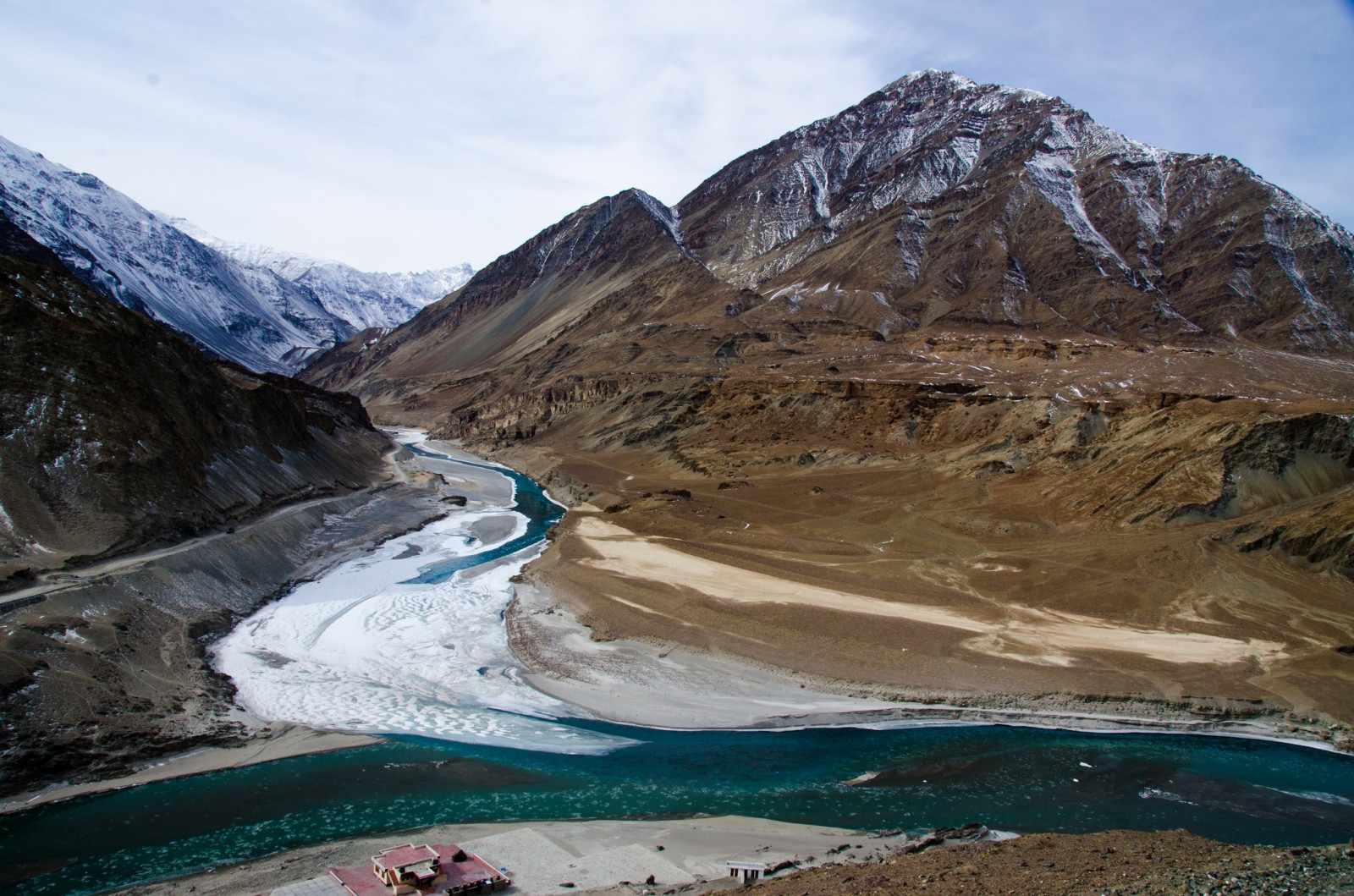
The Zanskar River joins the Indus River near Leh in Jammu and Kashmir. Though the Indus flows through India before reaching Pakistan, the 1960 Indus Water Treaty allocates the basin’s three eastern rivers to India and its three western rivers to Pakistan. Photo courtesy Pradeep Kumbhashi via Flickr Creative Commons
By Codi Kozacek
Circle of Blue
Officials in Pakistan are poised to take their clash with India over hydropower projects in Jammu and Kashmir to the highest levels of international arbitration. It marks the second time in five years that the confrontation has escalated to The Hague. Pakistan invoked the right to air its grievances before the seven-member court under the Indus Water Treaty, the bilateral agreement that administers water rights in the river basin that the two countries share and is the region’s economic lifeblood.
There is rising urgency for both India and Pakistan to address water management in the Indus Basin. The river begins its journey high in the western Himalayas and flows 3,000 kilometers before it empties into the Arabian Sea near Karachi. Along the way, it supports more than 17 gigawatts of hydropower capacity in India and Pakistan and feeds the Indus Basin Irrigation System, the largest contiguous irrigation network in the world. Pakistan is particularly dependent on the Indus—more than 90 percent of its agricultural production comes from the Basin, which in turn contributes a fifth of its gross domestic product.
The challenges Pakistan and India have faced over the past year are just one facet of chronic water management problems that are becoming increasingly urgent in a time of climate change, economic globalization, and population growth.
The fierce dispute now centers on Indian hydropower dams and water supplies on rivers that start in northern India and flow into Pakistan. The 330-megawatt Kishanganga project will divert water between two tributaries of the Jhelum River in Bandipora. The 850-megawatt Ratle project will generate electricity from the Chenab River in Kishtwar.
Both rivers are officially allocated to Pakistan under the Indus Water Treaty. But the agreement allows India limited rights to use the water within its borders, before the rivers enter Pakistan. Officials in Pakistan, however, have contended for years that the design of the run-of-the-river power projects violates the treaty by impeding and altering water flows to Pakistan.
“Talks for 2.5 years with India on resolution of Pakistan’s objections regarding Kishinganga & Ratle HEPs failed & Pakistan with the consent of stakeholders decided to take it to full court of arbitration,” Khawaja Asif, Pakistan’s minister for water and power and defense, posted on Twitter on July 15. The decision followed two days of discussions with the Indian government in New Delhi, and the case now heads to The Hague for hearings by a seven-member Court of Arbitration.
The escalation comes amid growing water concerns in both India and Pakistan. Before annual monsoon rains arrived in June, a quarter of India’s population was affected by a severe, two-year drought. Failed harvests forced rural families to migrate to cities like Mumbai to look for work and water, and farmer suicides skyrocketed in the agricultural areas of Maharashtra. Pakistan faced an equally dire scenario. Dry weather in the country’s cotton-growing regions meant the textile industry needed to import $US 4 billion of cotton to prop up its production, which contributes 9 percent to gross domestic product. And water and power shortages again created dangerous conditions this spring as heatwaves swept through cities in both countries. Now, both are contending with damaging and deadly floods triggered by the monsoon.
The challenges Pakistan and India have faced over the past year are just one facet of chronic water management problems that are becoming increasingly urgent in a time of climate change, economic globalization, and population growth. Climate model predictions for future water supplies in the Indus River Basin are frustratingly inconclusive for the near-term. Most agree that water flows will decline by the end of the century as glaciers in the Himalayas retreat.
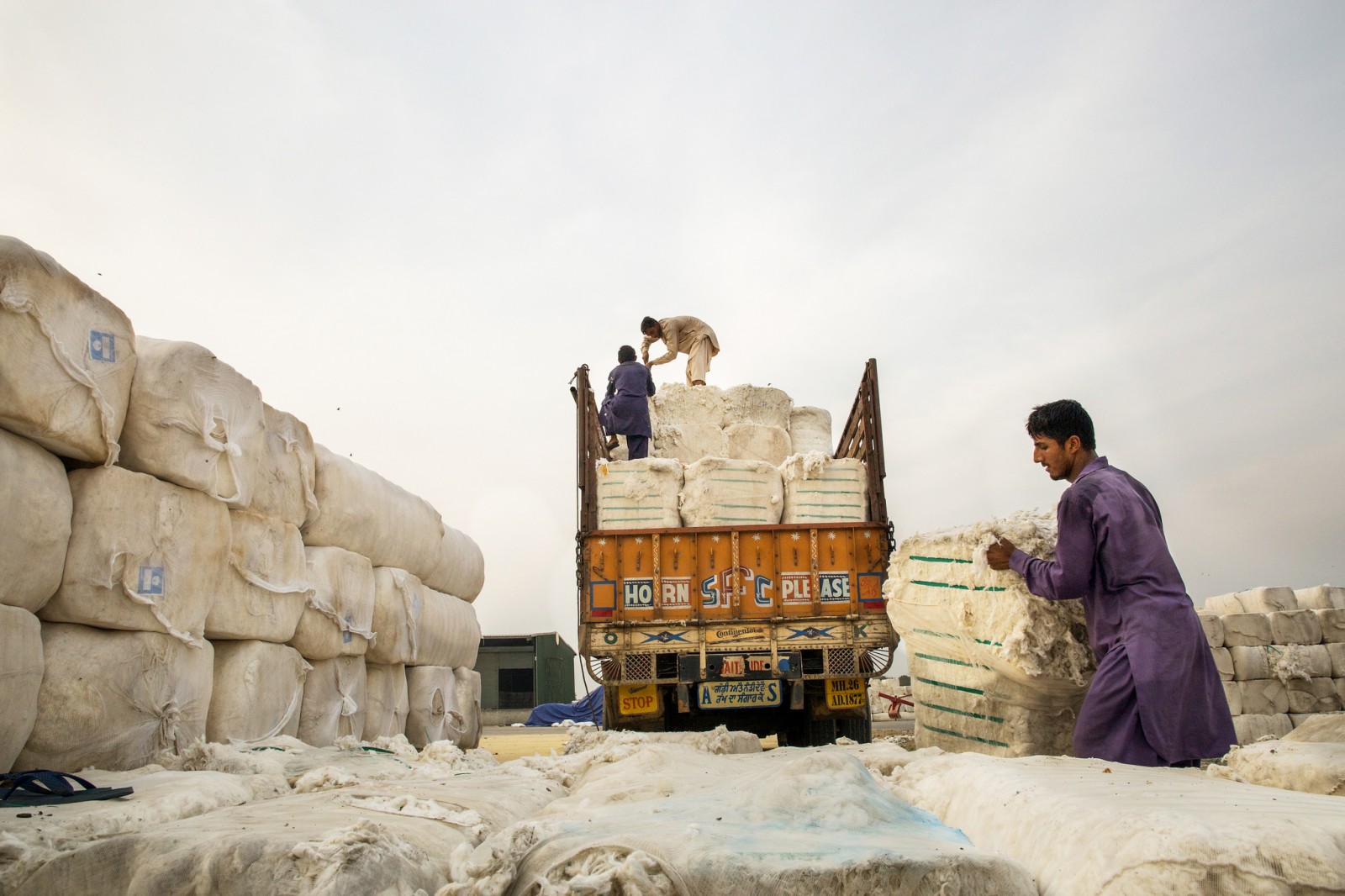
Workers unload cotton bales at the Wagah-Attari Cargo Terminal on the border of India and Pakistan. Dry conditions in Pakistan during the past year wilted crops and forced the textile industry to import $US 4 billion of cotton. Photo courtesy Asian Development Bank via Flickr Creative Commons
At the same time, the number of people living in the basin is expected to grow from about 300 million today to nearly 400 million by 2050. The intensification of industrial agriculture is also at play, putting pressure on small-scale farmers and leading to the rampant expansion of bore wells. Aquifers in northern India and Pakistan are now among the most stressed and rapidly declining in the world, according to data from NASA’s GRACE satellite.
“Much more so than the threat of open conflict between Pakistan and India, which I think is remote, the real human dangers are to public health and livelihoods in those two countries,” said David Michel, a nonresident fellow in environmental security at The Stimson Center, a nonpartisan think tank based in Washington, D.C.
Water scarcity in the Indus [Basin] is institutional, cultural, and political.” –Daanish Mustafa, Reader, King’s College London
Neither government, however, shows a serious inclination to address these problems, according to experts on the region’s water issues. And certainly not in a collaborative manner.
In the days since Pakistan announced it will appeal to The Hague, both countries began a familiar dance of distrust they have engaged in since the Indus Water Treaty was signed in 1960. Indian officials accused Pakistan of violating the treaty by moving too quickly to arbitration, while Pakistani news sites resurfaced accusations that the hydropower projects are part of a larger energy plan that would allow India to regulate water flows into Pakistan.
The aspersions and suspicions, however, do not indicate impending conflict, according to experts on the region. In every case of bitter disagreement over the past 50 years, the treaty has provided solutions acceptable—if not wholly satisfactory—to both parties. Instead, the perennial quarrel ignores critical water problems each country faces within its own borders and underscores the difficulty of updating the Indus Treaty to address issues such as groundwater management and climate change.
“Water scarcity in the Indus [Basin] is institutional, cultural, and political,” said Daanish Mustafa, reader in politics and environment at King’s College London. “If it was just the physical problem, it is solvable. There are solutions. It’s not as bad as it is made out to be. What should scare you is the incapacity of the institutions and the water managers to implement those solutions. The other things you can manage.”
A System Under Pressure
While the Indus has nurtured extensive agricultural and economic development, declines in per capita water availability due to population growth and inefficient water use are well documented on both sides of the border.
In May, the Pakistan Council of Research in Water Resources issued a warning that the country could reach “absolute water scarcity” within the next decade, according to The Express Tribune, a major English-language newspaper in Pakistan. The news followed a report from the previous month in which the Federation of Pakistan Chambers of Commerce and Industry called dwindling water supplies the “biggest threat” to the country. Overall, per capita water availability in Pakistan has declined from 5,600 cubic meters to 1,017 cubic meters over the past 70 years, according to a report by the International Monetary Fund, and the gap between supply and demand is expected to reach 83 million acre-feet by 2025.
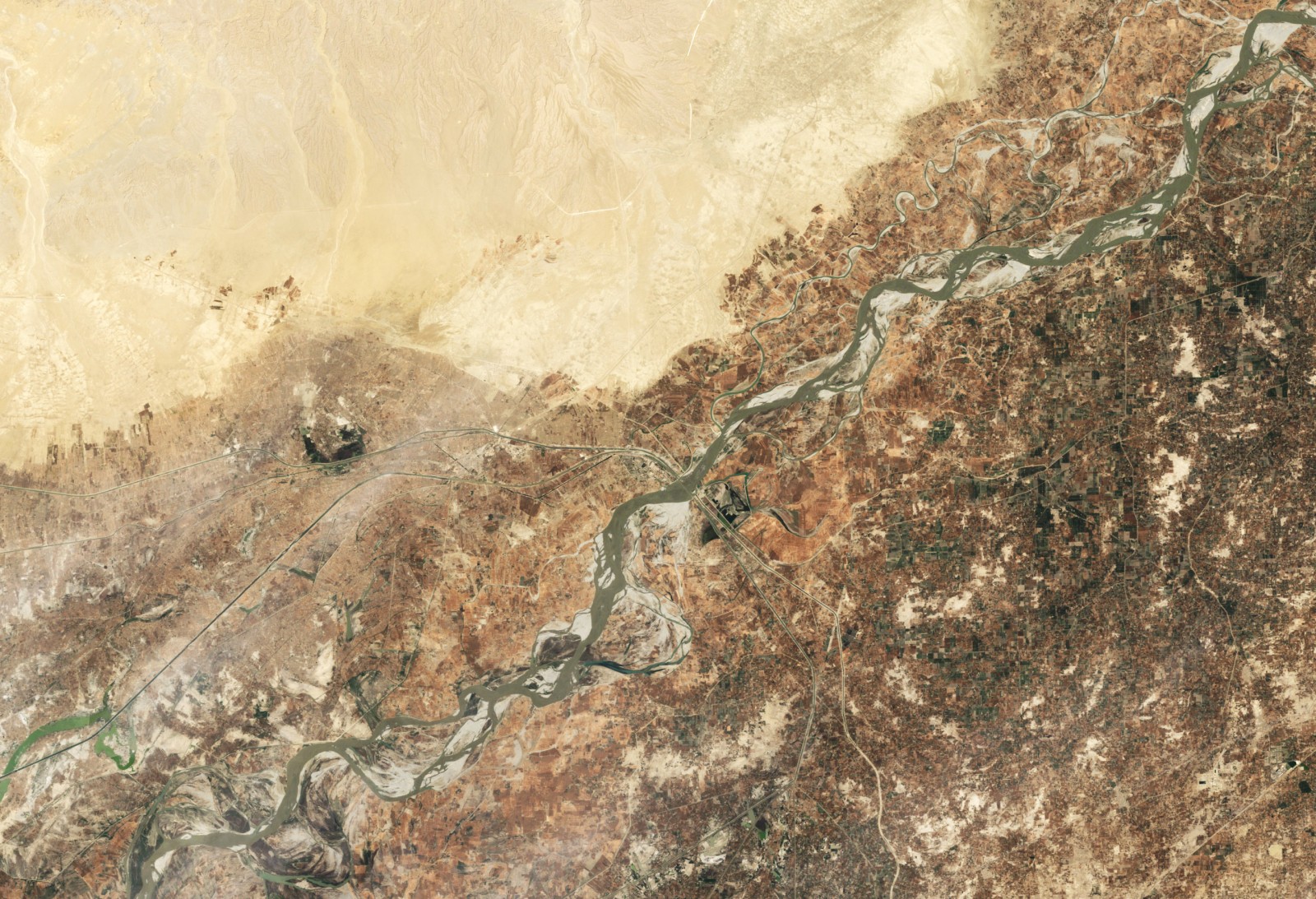
The Indus River is critical for agriculture and energy production in India and Pakistan. The shared river basin is home to at least 300 million people, and its water resources have long been a point of contention between the two countries. This image, captured by the Landsat 5 satellite in June 2009, shows the area around the Guddu Barrage, just south of the border between Punjab and Sindh provinces in Pakistan. Image courtesy NASA
Groundwater, too, is under pressure in some areas of the Indus Basin. In Indian Punjab, for example, part of which lies within the basin, there has been an average decline in groundwater levels of up to 0.75 meters per year over the past 20 years, according to a 2015 report by the British Geological Survey. Farther downstream, depletion has occurred at a rate of about 0.45 meters per year. Encouraged by government policies in India and Pakistan, both regions saw a rapid increase in the number of irrigation wells over the second half of the 20th century.
All of this comes as water supplies in the Indus Basin face an uncertain future. More than 40 percent of the basin’s stream flow originates from glaciers high in the western Himalayas, a greater proportion than any other major river system in the region. That means the Indus is particularly attuned to changes in glacial runoff.
Models suggest that in the Indus Basin there will be more volatility and variability in the water available, and the riparians need to prepare for that.” –David Michel, Nonresident Fellow, The Stimson Center
Scientists are still unraveling what climate change will mean for glaciers in the Himalayas and the rivers they feed downstream. A 2014 study published in the journal Nature Climate Change estimated that water runoff in the upper Indus Basin could increase as much as 7 to 12 percent by 2050 as higher temperatures melt glaciers, contributing to greater river flows. The bump in runoff, however, could be short-lived. The study’s authors told Nature in June that new research they have submitted for review shows a 15 percent decline from historic water flows by the end of the century.
Other research indicates that changes are already occurring. Water supplies on the Indus River and three of its tributaries declined 5 percent over the past five decades, according to unpublished data collected by a hydrologist at the Pakistan Water and Power Development Authority, Nature reported. Moreover, the data suggest that flows have declined during the summer months and increased only slightly during the winter. The shift may be explained by cooler temperatures in localized areas that have actually reduced glacial melt, and in turn led to declining river flows.
“Someone once said not to let a crisis go to waste. I wouldn’t yet characterize it as a crisis, and I certainly wouldn’t suggest that it should be manipulated to meet political ends, but under times of stress eyes are opened to risks and opportunities,” Michel told Circle of Blue. “Those risks and opportunities are coming more frequently and strongly under climate change. Models suggest that in the Indus Basin there will be more volatility and variability in the water available, and the riparians need to prepare for that.”
Same Basin, Different Problems
The narrative of looming water scarcity, however, misses a critical distinction between water resources in the Upper Indus and the Lower Indus basins, according to Mustafa. While groundwater in the upper reaches of the basin is largely fresh water, groundwater in the lower basin is salty, rendering it unusable for most purposes. Moreover, groundwater levels in the lower basin are actually rising at a rate of about 0.1 meters each year, according to the British Geological Survey report. The increase is due at least in part to extensive irrigation, which has contributed to waterlogging—a process in which the water table rises to such an extent that plants can no longer grow in the soil. As a result, both the groundwater and fields are contaminated with salt.
“When it comes to the Indus, I insist that there is no such thing as one Indus basin. It is two basins—a fresh groundwater zone and a saline groundwater zone,” Mustafa told Circle of Blue. “There is no water scarcity in the freshwater zone. The urgent problem is in the saline groundwater zone.”
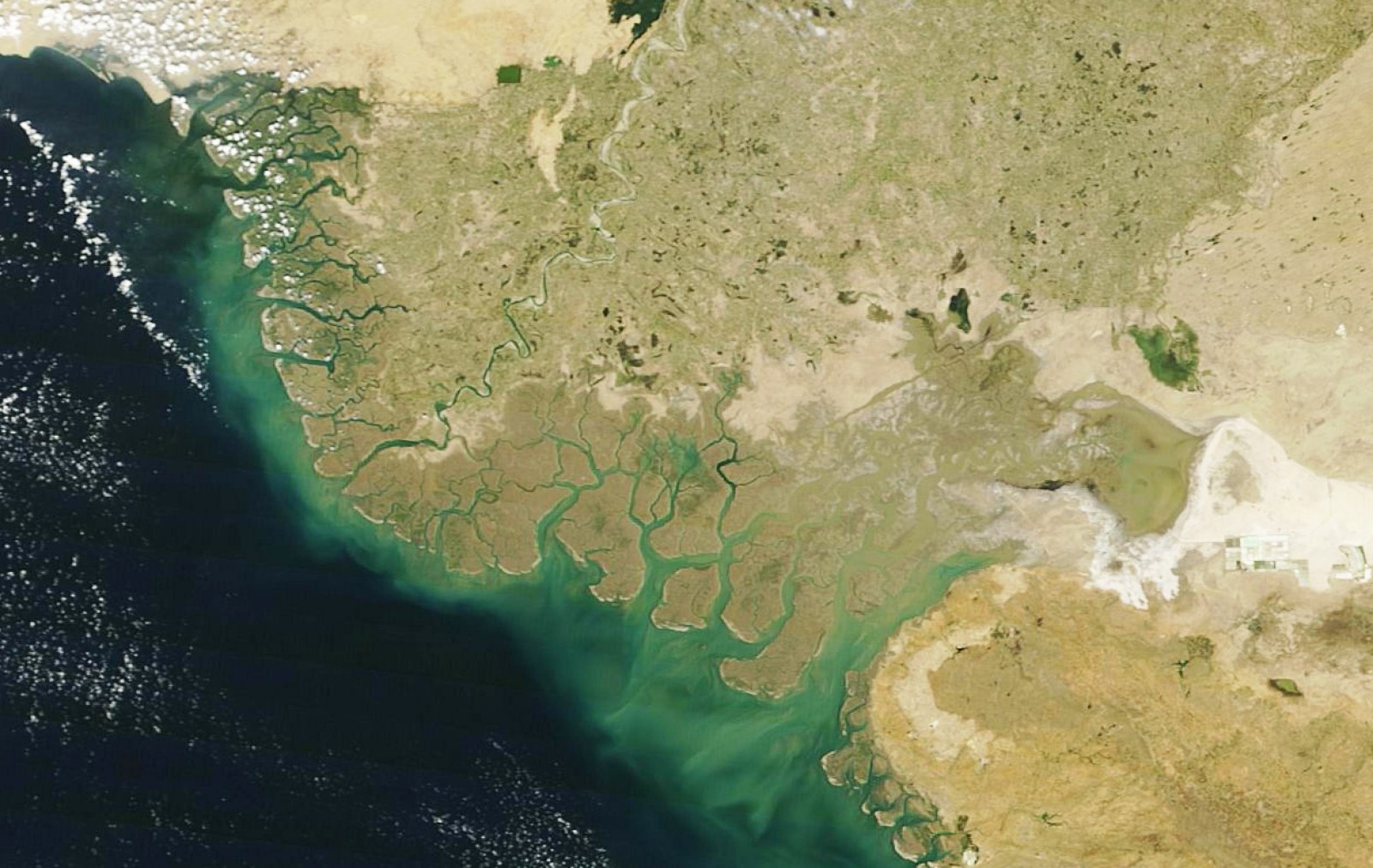
The Indus River travels 3,000 kilometers from the Himalayas before it empties into the Arabian Sea near Karachi. While groundwater reserves are rapidly declining in the upper reaches of the basin, groundwater in the lower basin is salty and largely unusable. This image of the Indus River Delta was captured in March 2016 by the Moderate Resolution Imaging Spectroradiometer (MODIS) sensor on board the Terra satellite. Photo courtesy NASA
Small farmers in the downstream areas are especially squeezed by water constraints. Most have to buy their inputs—such as seeds and fuel—on credit, and if their harvests are poor they are unable to repay their debts. Farmers who can no longer make a living off the land are moving to cities, contributing to an urbanization rate that is higher than anywhere else in South Asia.
“If you can’t get water when you need to plant, or you can’t buy the diesel for your irrigation pump, or you can’t afford seeds, that’s exactly the same as a drought,” said Mustafa.
“The small farmers are losing their shirts, abandoning their land, moving to cities, and becoming the people who live in urban shantytowns,” he added. “That is where the real disaster is unfolding.”
Groundwater salinity is also important reason that water users in Pakistan’s Sindh province, located in the lower basin, have engaged in frequent disputes with Pakistani Punjab, located upstream. Farmers in Sindh are highly dependent on fresh surface water from the Indus, and many view attempts by Punjab to build dams and reservoirs as a threat to their livelihoods. On the other hand, Pakistan can only store about 30 days worth of water on the Indus, and the government sees new dams and reservoirs as the only way to guard against highly seasonal and variable water flows throughout the basin.
Treaty, Policies Need Update
The Indus Water Treaty is largely considered a success in that it has avoided violent conflict between India and Pakistan for more than 50 years, even amid wars and a persistent atmosphere of distrust. It has done so in large part by avoiding messy directives about water flows and deliveries, instead simply allocating the basin’s three eastern rivers to India and its three western rivers to Pakistan. But there is a growing consensus that the agreement needs to be revamped to accommodate issues such as groundwater and changing climate conditions.
“The treaty in itself, and its mechanisms, have functioned well. Yet in the face of these rising challenges, all the riparians recognize that the treaty many not be adequate,” said Michel. “There’s an attitude of, ‘if it ain’t broke—you can argue about it—but don’t fix it’, because it could lead to destabilizing what is for both sides an unsatisfactory, but relatively acceptable, situation. At the same time, the ongoing political frictions between India and Pakistan, they underlie any discussion or agreements that might be developed to address climate change.”
Improving transparency and sharing data about water flows and dam operations could go a long way toward easing tensions between the two countries, according to both Michel and Mustafa. Pakistan, in particular, has repeatedly called for India to release information about river flows, but those data are often considered state secrets. The lack of transparency and data sharing between governments fuels divisive political rhetoric that is magnified by the media, promoting suspicion and public anger that is not conducive to solving the real water management problems that confront the basin.
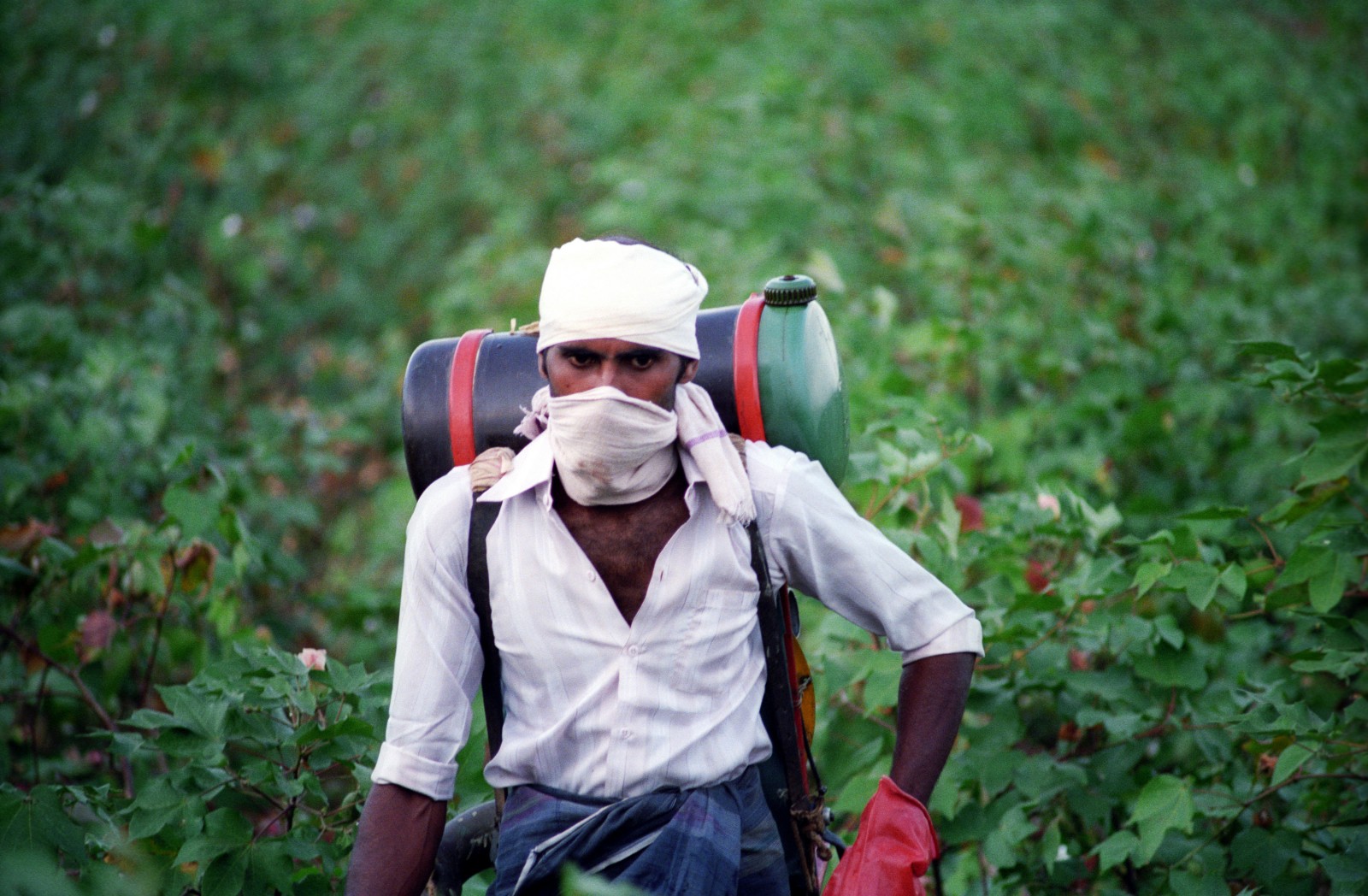
A farmer tends a cotton field in Pakistan in 2010. The Indus Basin Irrigation System is the largest contiguous irrigation network in the world, and more than 90 percent of Pakistan’s agricultural production comes from the Indus Basin. Photo courtesy IFPRI via Flickr Creative Commons
A similar dynamic is at play in the disputes between Sindh and Pakistani Punjab. There are a variety of steps the government and farmers could take to save water and make its distribution more equitable, according to Mustafa. For example, water rate structures could be reconfigured to encourage conservation and ensure that the largest farms are paying their fair share. Farmers could also switch to less water-intensive crops, and some canals could be redesigned to reduce water loss and improve the timing of water deliveries, particularly in the saline groundwater zones where the poorest farmers live. The accusations hurled by politicians and the media, however, take attention away from these solutions.
There is a growing consensus that the Indus Water Treaty needs to be revamped to accommodate issues such as groundwater and changing climate conditions.
“Water has become yet another element where right-wing politicians are thumping their chests,” Mustafa said. “Of course that removes any rationality from the debate.”
But while underlying resentments make it difficult to overhaul water policies at both the provincial and international levels, India and Pakistan could more fully exploit the provisions that already exist within the Indus Water Treaty to improve the basin’s management, according to Michel. Greater sharing of data, for example, would not necessarily require new agreements between the countries. Instead, the governments could acknowledge that data sharing is part of the pragmatic relationship already outlined in the treaty, and that it does not represent a transition to cozier ties.
“There are real management challenges and stress on the shared resources of the Indus, and the existence of a functioning cooperative treaty is not necessarily adequate to address those challenges. And also the institutions and governing mechanisms are under pressure,” said Michel. “But they are not as fragile as all that. They can be used, I believe, to meet these challenges. But in addition to the black and white of the letters on the page of the treaty, there needs to be the political vision and political will brought to bear on these problems.”
A news correspondent for Circle of Blue based out of Hawaii. She writes The Stream, Circle of Blue’s daily digest of international water news trends. Her interests include food security, ecology and the Great Lakes.
Contact Codi Kozacek

